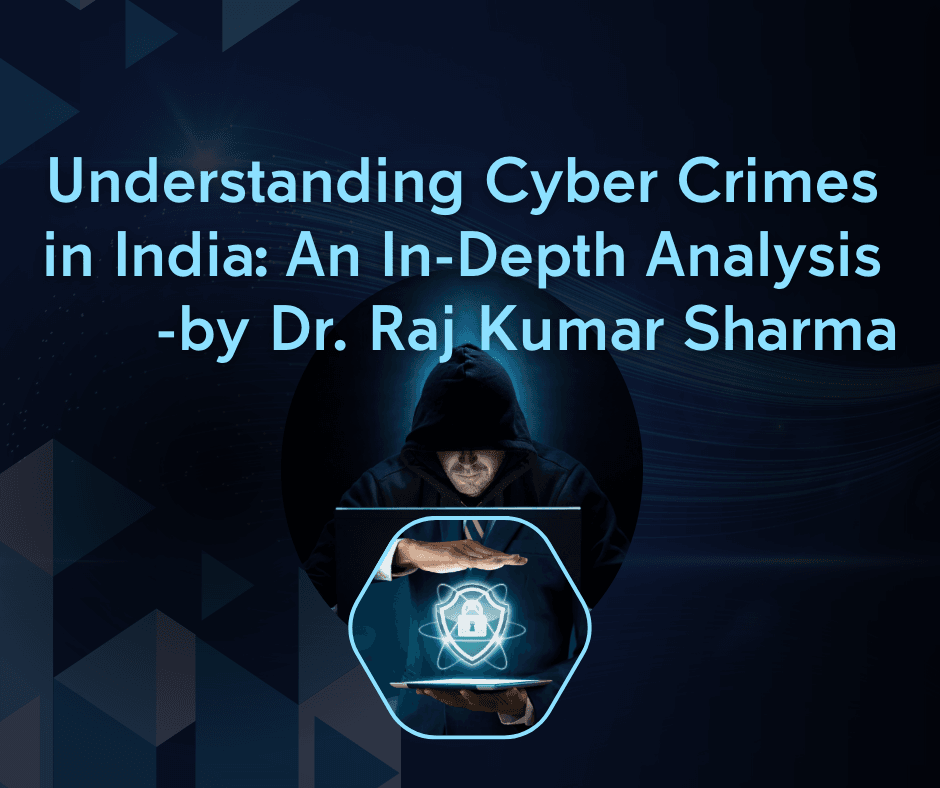
Understanding Cyber Crimes in India: An In-Depth Analysis – Dr. Raj Kumar Sharma
Understanding Cyber Crimes in India: An In-Depth Analysis
Introduction
As India rapidly advances into the digital age, the proliferation of technology has brought about numerous benefits and opportunities. However, this transformation also comes with a significant downside: an alarming increase in cyber crimes. Cyber crimes refer to illegal activities conducted through the internet or involving computer systems, and they have become a pressing concern for individuals, businesses, and the government alike. In this article, we will explore various types of cyber crimes prevalent in India, their implications, and real-world examples that illustrate the severity of this issue.
The Rise of Cyber Crimes in India
Historical Context
India’s digital journey began in earnest in the 1990s, and with the rise of the internet, the nation has witnessed an unprecedented expansion in online activities. While this growth has facilitated economic development, it has also created a fertile ground for cyber criminals. The Information Technology Act of 2000 was one of the first legislative measures aimed at addressing cyber crimes in India. Despite this, the landscape of cyber crimes continues to evolve, becoming increasingly sophisticated.
Cyber Crime Statistics
According to the National Crime Records Bureau (NCRB), the number of cyber crime cases in India has surged significantly in recent years. For instance, the NCRB reported over 50,000 cases of cyber crimes in 2020, marking a staggering increase compared to previous years. The COVID-19 pandemic further exacerbated the situation, as more people turned to online platforms for work, shopping, and socializing, making them more vulnerable to cyber threats.
Types of Cyber Crimes in India
Cyber crimes can be broadly categorized into various types, each posing unique challenges. Here are some of the most prevalent forms of cyber crimes in India:
- Hacking
Definition: Hacking involves unauthorized access to computer systems or networks, often with malicious intent.
Example: In 2020, a major data breach occurred at an Indian online grocery delivery service. Cyber criminals accessed personal data of over 20 million users, including names, email addresses, and phone numbers. The incident highlighted the vulnerabilities in data security and the risks consumers face when engaging with online services.
- Phishing
Definition: Phishing is a fraudulent attempt to obtain sensitive information, such as usernames and passwords, by disguising as a trustworthy entity in electronic communications.
Example: A common phishing scam in India involves fake emails that appear to be from banks. In one case, customers of a Bank received emails requesting them to verify their account details. Many unsuspecting users fell victim, leading to unauthorized transactions and significant financial losses.
- Identity Theft
Definition: Identity theft occurs when an individual’s personal information is stolen and used without their consent, often for financial gain.
Example: In 2019, a woman in became a victim of identity theft when her personal details were stolen to take out loans totaling over ₹5 lakh. The fraudsters used her information to create fake identity documents, leading to legal troubles for the victim.
- Cyberbullying
Definition: Cyberbullying involves the use of digital platforms to harass, threaten, or intimidate individuals, often leading to severe emotional distress.
Example: The case of a teenage girl who faced relentless online harassment highlights the severity of cyberbullying in India. She was targeted by a group on social media, leading to her withdrawing from school and suffering from anxiety and depression. Such cases underline the urgent need for awareness and intervention.
- Ransomware Attacks
Definition: Ransomware is a type of malicious software that locks users out of their systems, demanding a ransom for access.
Example: In 2021, a ransomware attack targeted several healthcare institutions in India during the COVID-19 pandemic, crippling their operations. The attackers demanded substantial ransoms, causing delays in critical healthcare services and endangering lives.
- Online Fraud
Definition: Online fraud encompasses various scams conducted over the internet, including advance-fee fraud and fake lottery scams.
Example: In 2020, a group of individuals was arrested for running a fake lottery scam that targeted unsuspecting victims across the country. They informed people they had won large sums of money but needed to pay a fee to claim their winnings. Many victims lost significant amounts before realizing the scam.
- Cyber Terrorism
Definition: Cyber terrorism involves politically motivated attacks aimed at intimidating or coercing a society or government.
Example: A notorious case involved a hacker group threatening to disrupt government’s systems and critical infrastructure, including power grids and railways. Although the attack did not succeed, it raised alarms about the vulnerabilities in national security.
- Data Breaches
Definition: Data breaches occur when unauthorized individuals gain access to sensitive data, often leading to data theft or manipulation.
Example: In a data breach in 2017, where hackers stole data from 17 million user accounts, serves as a prominent example. The breach raised concerns about the security measures employed by online food delivery platforms and the protection of user data.
Implications of Cyber Crimes
Economic Impact
The financial implications of cyber crimes are staggering. The cost of cyber crime to the Indian economy is estimated to reach billions of dollars each year. Businesses face losses from stolen data, recovery costs, and reputational damage. For instance, after the BigBasket data breach, the company had to invest heavily in upgrading its cybersecurity infrastructure.
Psychological Impact
The psychological impact of cyber crimes, particularly cyberbullying and identity theft, can be devastating. Victims may experience anxiety, depression, and a sense of violation. In severe cases, individuals have resorted to self-harm or suicide due to relentless online harassment.
Social Impact
Cyber crimes can erode trust in online platforms and services. As incidents of fraud and data breaches become more common, users may become hesitant to engage in online transactions, hampering the growth of e-commerce and digital services.
National Security Concerns
Cyber crimes also pose a significant threat to national security. Attacks on critical infrastructure, such as power grids or banking systems, can disrupt essential services and pose risks to public safety. The Indian government has recognized this threat and is taking steps to bolster cybersecurity measures.
Legal Framework Addressing Cyber Crimes
Information Technology Act, 2000
The Information Technology Act serves as the primary legislation governing cyber crimes in India. It provides a framework for legal recognition of electronic transactions and outlines various offenses related to hacking, data theft, and identity fraud. The Act has undergone amendments, with the most notable being in 2008, which expanded the scope of offenses and introduced stricter penalties.
Indian Penal Code (IPC)
The Indian Penal Code complements the IT Act by addressing offenses that can occur in the digital space. Relevant sections cover crimes like defamation, forgery, and stalking, thus extending traditional criminal laws to the cyber realm.
Data Protection Laws
Although the Data Protection Bill is still under consideration, its potential enactment would significantly enhance data privacy and protection standards in India. It aims to regulate how personal data is collected, stored, and processed, empowering individuals to have greater control over their information.
Cyber Crime Cells
In response to the rising tide of cyber crimes, various states have established Cyber Crime Cells to investigate and prosecute cyber offenses. These specialized units are equipped to handle digital evidence and work closely with law enforcement agencies to combat cyber threats.
Challenges in Combating Cyber Crimes
Despite the legal framework and initiatives in place, several challenges hinder the effective prevention and prosecution of cyber crimes in India:
1.Lack of Awareness
A significant portion of the population remains unaware of the risks associated with cyber crimes and how to protect themselves. This lack of awareness makes individuals and businesses more vulnerable to attacks.
2.Underreporting of Cyber Crimes
Many victims of cyber crimes choose not to report incidents due to fear of embarrassment, lack of trust in law enforcement, or the belief that nothing can be done. This underreporting skews statistics and hampers efforts to address the issue.
3.Rapid Technological Advancements
The rapid pace of technological advancements often outstrips existing legal frameworks and law enforcement capabilities. Cyber criminals continually adapt to new technologies, making it challenging for authorities to keep up.
4.Jurisdictional Issues
Cyber crimes often transcend national boundaries, complicating investigations and prosecutions. Cooperation between countries is essential, yet legal differences can hinder collaborative efforts.
5.Resource Limitations
Many law enforcement agencies lack the necessary resources, training, and technical expertise to effectively investigate and prosecute cyber crimes. As a result, cases may go unresolved or take an extended period to reach a conclusion.
Building Cyber Resilience
To combat the growing threat of cyber crimes, India must focus on building cyber resilience at various levels:
1.Public Awareness Campaigns
Launching nationwide awareness campaigns to educate citizens about cyber threats and safe online practices is crucial. Schools, workplaces, and community organizations can play a vital role in disseminating information.
2.Strengthening Legal Frameworks
Updating existing laws to address emerging cyber threats is essential. The enactment of the Data Protection Bill and the formulation of more comprehensive cyber laws can help enhance protection for individuals and organizations.
3.Investment in Cybersecurity
Both the government and private sectors must invest in robust cybersecurity measures. Organizations should implement multi-layered security protocols, conduct regular security audits, and provide employee training on cybersecurity best practices.
4.Enhancing Law Enforcement Capabilities
Training law enforcement personnel in cyber investigation techniques and providing them with advanced tools and resources will improve their ability to tackle cyber crimes effectively.
5.Promoting International Collaboration
Engaging in international partnerships and treaties focused on cybersecurity can enhance global cooperation
Conclusion
The landscape of cyber crimes in India is complex and continually evolving. As digital technologies continue to permeate every aspect of life, the importance of addressing cyber crimes cannot be overstated. The impact of these crimes is far-reaching, affecting individuals, businesses, and national security.
While legal frameworks like the Information Technology Act provide a foundation for combating cyber crimes, a multifaceted approach is necessary to build resilience against these threats. This includes public awareness campaigns, investment in cybersecurity, strengthening law enforcement capabilities, and fostering international collaboration.
By collectively addressing the challenges posed by cyber crimes, India can work towards creating a safer digital environment for all its citizens. As we move further into the digital age, a proactive approach to cybersecurity is not just beneficial—it is imperative for the nation’s security and economic growth.





This Post Has 0 Comments